Evaluating Communication Barriers' Impact on Business Objectives
VerifiedAdded on 2021/02/03
|5
|2005
|43
Essay
AI Summary
This essay examines the multifaceted nature of communication barriers within a business context, analyzing their detrimental effects on both individual employees and collaborative team efforts in achieving organizational goals and objectives. It defines communication and emphasizes its crucial role in management and leadership, highlighting various communication methods like one-on-one interactions and written text. The essay identifies common communication barriers, including language differences, environmental noise, channel issues, receiver attitudes, transmission complexities, and physical distances. Furthermore, it evaluates strategies for overcoming these barriers, such as active listening, empathy, body language awareness, self-assessment through recording, using simple language, and seeking feedback. The essay then delves into specific strategies like feedback and the Johari Window model to enhance communication effectiveness, ultimately concluding that effective communication is paramount for organizational success and requires conscious efforts from all levels of the company to create a clear, open-minded, and audience-centric approach.
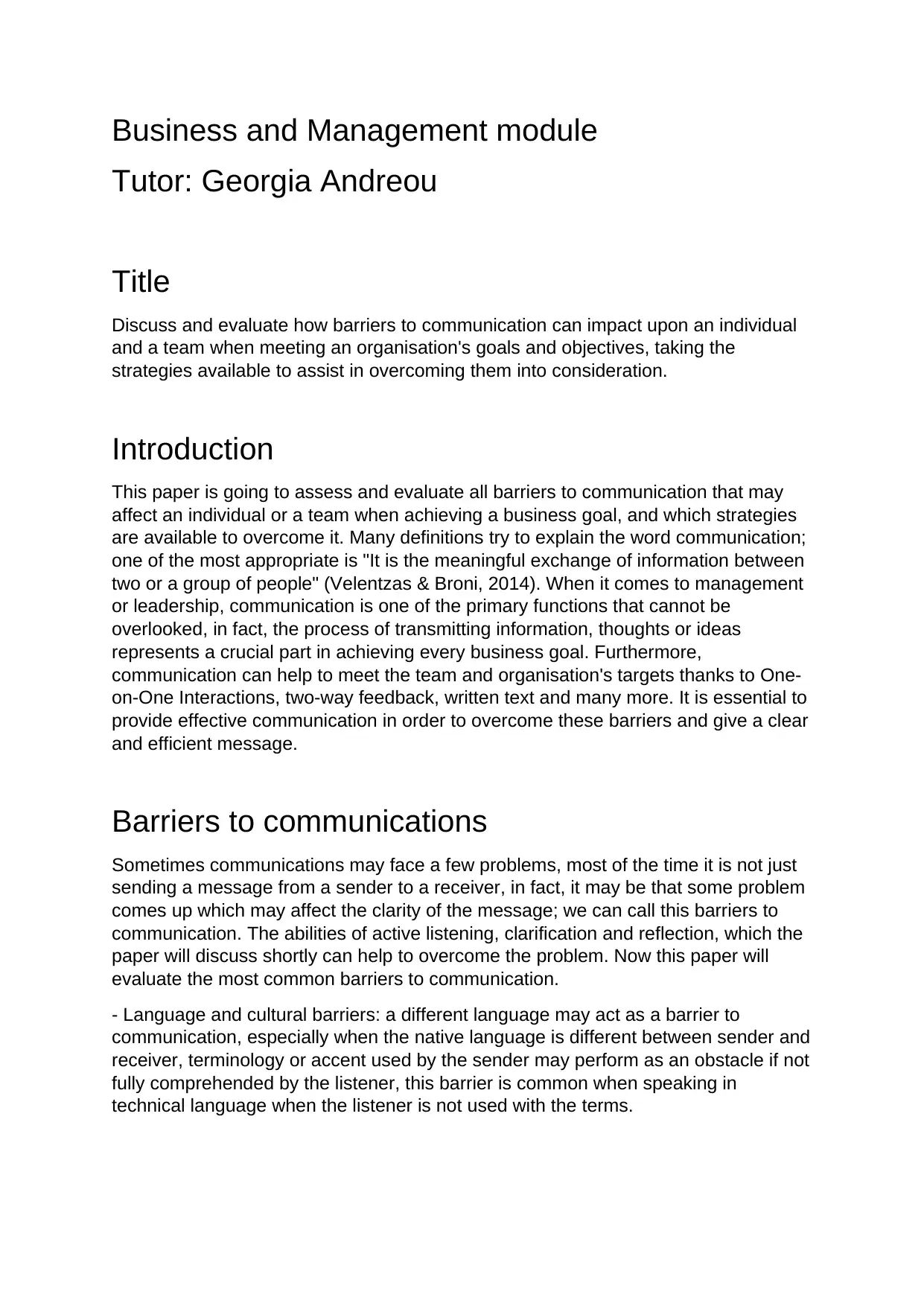
Business and Management module
Tutor: Georgia Andreou
Title
Discuss and evaluate how barriers to communication can impact upon an individual
and a team when meeting an organisation's goals and objectives, taking the
strategies available to assist in overcoming them into consideration.
Introduction
This paper is going to assess and evaluate all barriers to communication that may
affect an individual or a team when achieving a business goal, and which strategies
are available to overcome it. Many definitions try to explain the word communication;
one of the most appropriate is "It is the meaningful exchange of information between
two or a group of people" (Velentzas & Broni, 2014). When it comes to management
or leadership, communication is one of the primary functions that cannot be
overlooked, in fact, the process of transmitting information, thoughts or ideas
represents a crucial part in achieving every business goal. Furthermore,
communication can help to meet the team and organisation's targets thanks to One-
on-One Interactions, two-way feedback, written text and many more. It is essential to
provide effective communication in order to overcome these barriers and give a clear
and efficient message.
Barriers to communications
Sometimes communications may face a few problems, most of the time it is not just
sending a message from a sender to a receiver, in fact, it may be that some problem
comes up which may affect the clarity of the message; we can call this barriers to
communication. The abilities of active listening, clarification and reflection, which the
paper will discuss shortly can help to overcome the problem. Now this paper will
evaluate the most common barriers to communication.
- Language and cultural barriers: a different language may act as a barrier to
communication, especially when the native language is different between sender and
receiver, terminology or accent used by the sender may perform as an obstacle if not
fully comprehended by the listener, this barrier is common when speaking in
technical language when the listener is not used with the terms.
Tutor: Georgia Andreou
Title
Discuss and evaluate how barriers to communication can impact upon an individual
and a team when meeting an organisation's goals and objectives, taking the
strategies available to assist in overcoming them into consideration.
Introduction
This paper is going to assess and evaluate all barriers to communication that may
affect an individual or a team when achieving a business goal, and which strategies
are available to overcome it. Many definitions try to explain the word communication;
one of the most appropriate is "It is the meaningful exchange of information between
two or a group of people" (Velentzas & Broni, 2014). When it comes to management
or leadership, communication is one of the primary functions that cannot be
overlooked, in fact, the process of transmitting information, thoughts or ideas
represents a crucial part in achieving every business goal. Furthermore,
communication can help to meet the team and organisation's targets thanks to One-
on-One Interactions, two-way feedback, written text and many more. It is essential to
provide effective communication in order to overcome these barriers and give a clear
and efficient message.
Barriers to communications
Sometimes communications may face a few problems, most of the time it is not just
sending a message from a sender to a receiver, in fact, it may be that some problem
comes up which may affect the clarity of the message; we can call this barriers to
communication. The abilities of active listening, clarification and reflection, which the
paper will discuss shortly can help to overcome the problem. Now this paper will
evaluate the most common barriers to communication.
- Language and cultural barriers: a different language may act as a barrier to
communication, especially when the native language is different between sender and
receiver, terminology or accent used by the sender may perform as an obstacle if not
fully comprehended by the listener, this barrier is common when speaking in
technical language when the listener is not used with the terms.
Paraphrase This Document
Need a fresh take? Get an instant paraphrase of this document with our AI Paraphraser
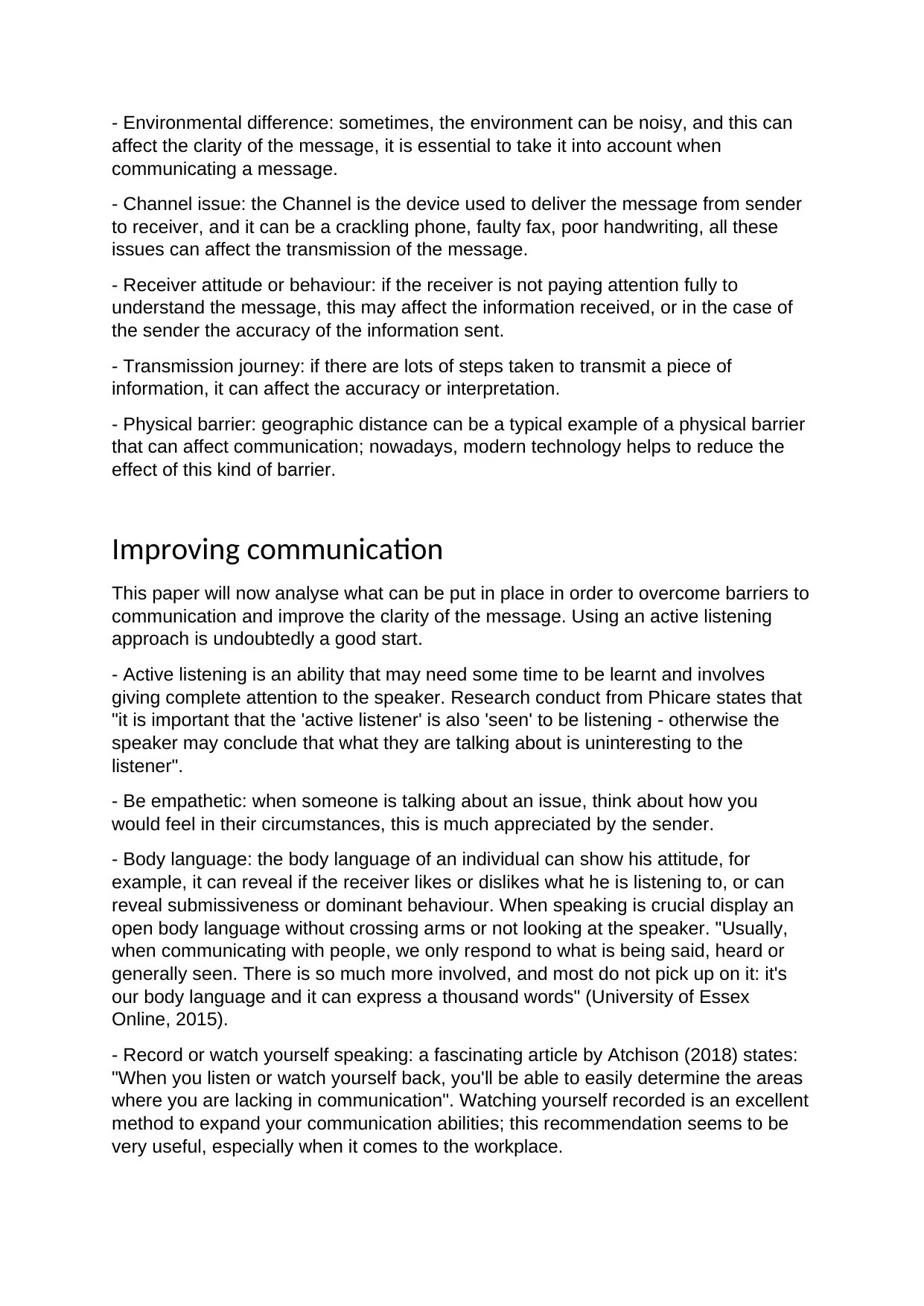
- Environmental difference: sometimes, the environment can be noisy, and this can
affect the clarity of the message, it is essential to take it into account when
communicating a message.
- Channel issue: the Channel is the device used to deliver the message from sender
to receiver, and it can be a crackling phone, faulty fax, poor handwriting, all these
issues can affect the transmission of the message.
- Receiver attitude or behaviour: if the receiver is not paying attention fully to
understand the message, this may affect the information received, or in the case of
the sender the accuracy of the information sent.
- Transmission journey: if there are lots of steps taken to transmit a piece of
information, it can affect the accuracy or interpretation.
- Physical barrier: geographic distance can be a typical example of a physical barrier
that can affect communication; nowadays, modern technology helps to reduce the
effect of this kind of barrier.
Improving communication
This paper will now analyse what can be put in place in order to overcome barriers to
communication and improve the clarity of the message. Using an active listening
approach is undoubtedly a good start.
- Active listening is an ability that may need some time to be learnt and involves
giving complete attention to the speaker. Research conduct from Phicare states that
"it is important that the 'active listener' is also 'seen' to be listening - otherwise the
speaker may conclude that what they are talking about is uninteresting to the
listener".
- Be empathetic: when someone is talking about an issue, think about how you
would feel in their circumstances, this is much appreciated by the sender.
- Body language: the body language of an individual can show his attitude, for
example, it can reveal if the receiver likes or dislikes what he is listening to, or can
reveal submissiveness or dominant behaviour. When speaking is crucial display an
open body language without crossing arms or not looking at the speaker. "Usually,
when communicating with people, we only respond to what is being said, heard or
generally seen. There is so much more involved, and most do not pick up on it: it's
our body language and it can express a thousand words" (University of Essex
Online, 2015).
- Record or watch yourself speaking: a fascinating article by Atchison (2018) states:
"When you listen or watch yourself back, you'll be able to easily determine the areas
where you are lacking in communication". Watching yourself recorded is an excellent
method to expand your communication abilities; this recommendation seems to be
very useful, especially when it comes to the workplace.
affect the clarity of the message, it is essential to take it into account when
communicating a message.
- Channel issue: the Channel is the device used to deliver the message from sender
to receiver, and it can be a crackling phone, faulty fax, poor handwriting, all these
issues can affect the transmission of the message.
- Receiver attitude or behaviour: if the receiver is not paying attention fully to
understand the message, this may affect the information received, or in the case of
the sender the accuracy of the information sent.
- Transmission journey: if there are lots of steps taken to transmit a piece of
information, it can affect the accuracy or interpretation.
- Physical barrier: geographic distance can be a typical example of a physical barrier
that can affect communication; nowadays, modern technology helps to reduce the
effect of this kind of barrier.
Improving communication
This paper will now analyse what can be put in place in order to overcome barriers to
communication and improve the clarity of the message. Using an active listening
approach is undoubtedly a good start.
- Active listening is an ability that may need some time to be learnt and involves
giving complete attention to the speaker. Research conduct from Phicare states that
"it is important that the 'active listener' is also 'seen' to be listening - otherwise the
speaker may conclude that what they are talking about is uninteresting to the
listener".
- Be empathetic: when someone is talking about an issue, think about how you
would feel in their circumstances, this is much appreciated by the sender.
- Body language: the body language of an individual can show his attitude, for
example, it can reveal if the receiver likes or dislikes what he is listening to, or can
reveal submissiveness or dominant behaviour. When speaking is crucial display an
open body language without crossing arms or not looking at the speaker. "Usually,
when communicating with people, we only respond to what is being said, heard or
generally seen. There is so much more involved, and most do not pick up on it: it's
our body language and it can express a thousand words" (University of Essex
Online, 2015).
- Record or watch yourself speaking: a fascinating article by Atchison (2018) states:
"When you listen or watch yourself back, you'll be able to easily determine the areas
where you are lacking in communication". Watching yourself recorded is an excellent
method to expand your communication abilities; this recommendation seems to be
very useful, especially when it comes to the workplace.
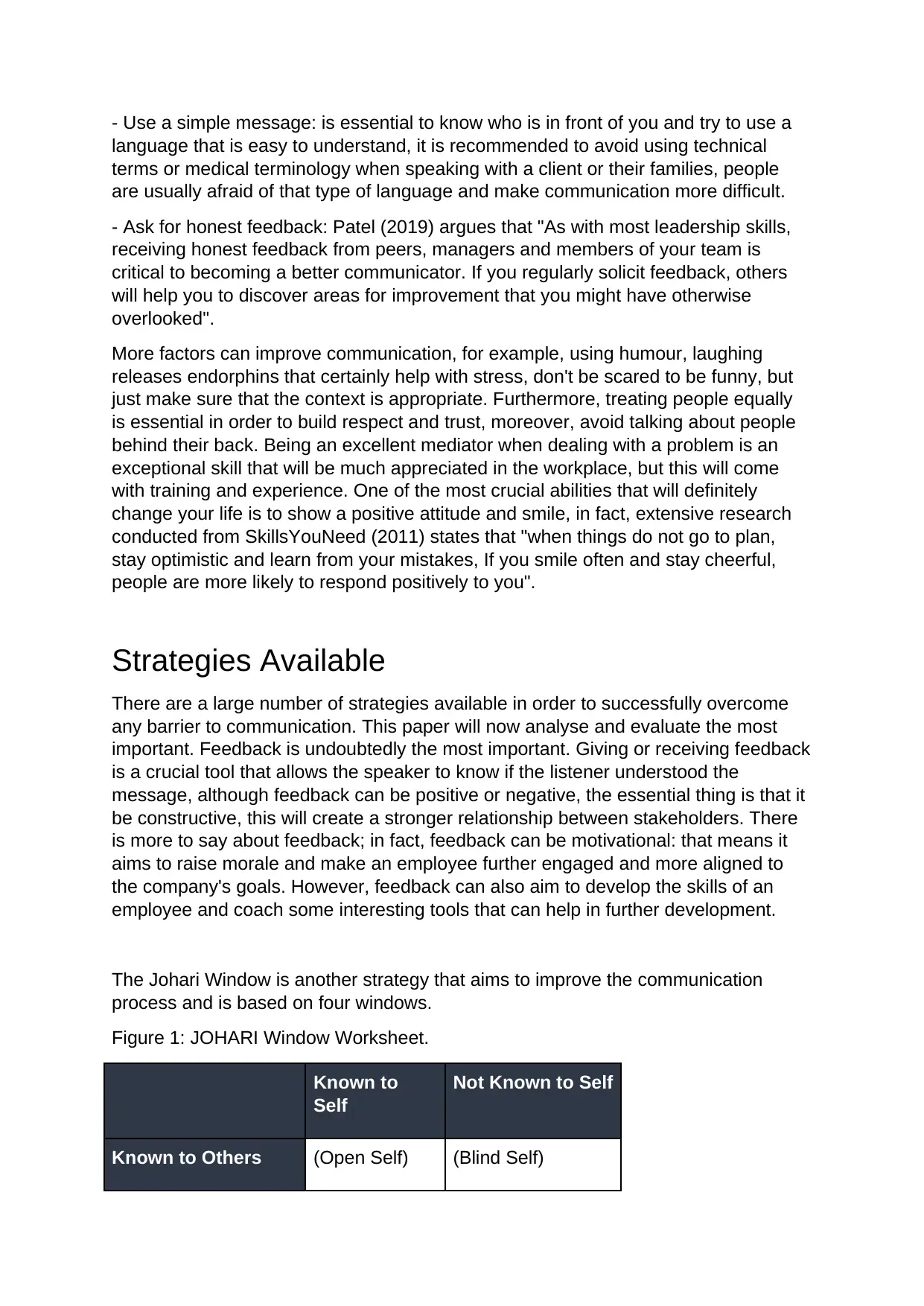
- Use a simple message: is essential to know who is in front of you and try to use a
language that is easy to understand, it is recommended to avoid using technical
terms or medical terminology when speaking with a client or their families, people
are usually afraid of that type of language and make communication more difficult.
- Ask for honest feedback: Patel (2019) argues that "As with most leadership skills,
receiving honest feedback from peers, managers and members of your team is
critical to becoming a better communicator. If you regularly solicit feedback, others
will help you to discover areas for improvement that you might have otherwise
overlooked".
More factors can improve communication, for example, using humour, laughing
releases endorphins that certainly help with stress, don't be scared to be funny, but
just make sure that the context is appropriate. Furthermore, treating people equally
is essential in order to build respect and trust, moreover, avoid talking about people
behind their back. Being an excellent mediator when dealing with a problem is an
exceptional skill that will be much appreciated in the workplace, but this will come
with training and experience. One of the most crucial abilities that will definitely
change your life is to show a positive attitude and smile, in fact, extensive research
conducted from SkillsYouNeed (2011) states that "when things do not go to plan,
stay optimistic and learn from your mistakes, If you smile often and stay cheerful,
people are more likely to respond positively to you".
Strategies Available
There are a large number of strategies available in order to successfully overcome
any barrier to communication. This paper will now analyse and evaluate the most
important. Feedback is undoubtedly the most important. Giving or receiving feedback
is a crucial tool that allows the speaker to know if the listener understood the
message, although feedback can be positive or negative, the essential thing is that it
be constructive, this will create a stronger relationship between stakeholders. There
is more to say about feedback; in fact, feedback can be motivational: that means it
aims to raise morale and make an employee further engaged and more aligned to
the company's goals. However, feedback can also aim to develop the skills of an
employee and coach some interesting tools that can help in further development.
The Johari Window is another strategy that aims to improve the communication
process and is based on four windows.
Figure 1: JOHARI Window Worksheet.
Known to
Self
Not Known to Self
Known to Others (Open Self) (Blind Self)
language that is easy to understand, it is recommended to avoid using technical
terms or medical terminology when speaking with a client or their families, people
are usually afraid of that type of language and make communication more difficult.
- Ask for honest feedback: Patel (2019) argues that "As with most leadership skills,
receiving honest feedback from peers, managers and members of your team is
critical to becoming a better communicator. If you regularly solicit feedback, others
will help you to discover areas for improvement that you might have otherwise
overlooked".
More factors can improve communication, for example, using humour, laughing
releases endorphins that certainly help with stress, don't be scared to be funny, but
just make sure that the context is appropriate. Furthermore, treating people equally
is essential in order to build respect and trust, moreover, avoid talking about people
behind their back. Being an excellent mediator when dealing with a problem is an
exceptional skill that will be much appreciated in the workplace, but this will come
with training and experience. One of the most crucial abilities that will definitely
change your life is to show a positive attitude and smile, in fact, extensive research
conducted from SkillsYouNeed (2011) states that "when things do not go to plan,
stay optimistic and learn from your mistakes, If you smile often and stay cheerful,
people are more likely to respond positively to you".
Strategies Available
There are a large number of strategies available in order to successfully overcome
any barrier to communication. This paper will now analyse and evaluate the most
important. Feedback is undoubtedly the most important. Giving or receiving feedback
is a crucial tool that allows the speaker to know if the listener understood the
message, although feedback can be positive or negative, the essential thing is that it
be constructive, this will create a stronger relationship between stakeholders. There
is more to say about feedback; in fact, feedback can be motivational: that means it
aims to raise morale and make an employee further engaged and more aligned to
the company's goals. However, feedback can also aim to develop the skills of an
employee and coach some interesting tools that can help in further development.
The Johari Window is another strategy that aims to improve the communication
process and is based on four windows.
Figure 1: JOHARI Window Worksheet.
Known to
Self
Not Known to Self
Known to Others (Open Self) (Blind Self)
⊘ This is a preview!⊘
Do you want full access?
Subscribe today to unlock all pages.

Trusted by 1+ million students worldwide
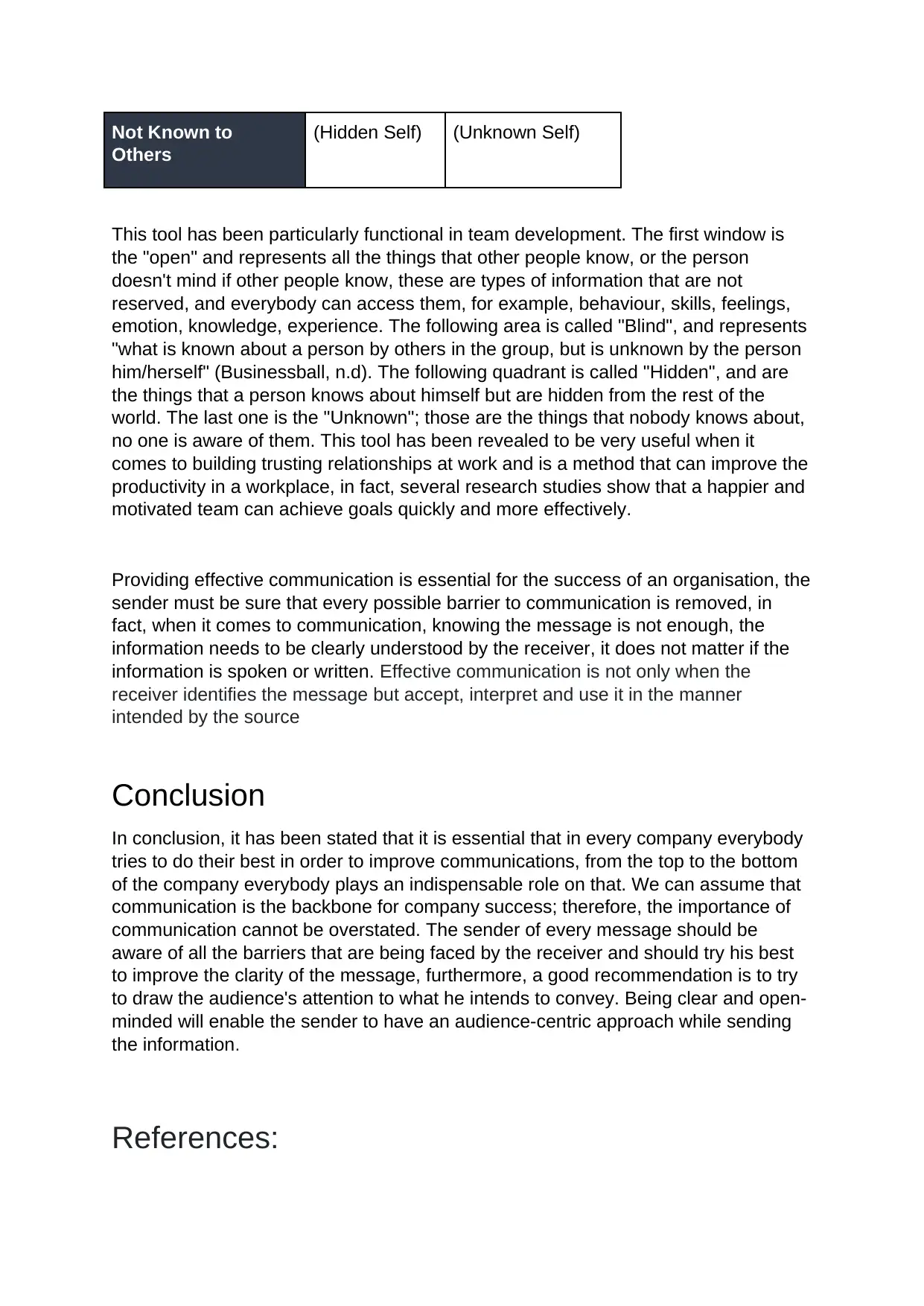
Not Known to
Others
(Hidden Self) (Unknown Self)
This tool has been particularly functional in team development. The first window is
the "open" and represents all the things that other people know, or the person
doesn't mind if other people know, these are types of information that are not
reserved, and everybody can access them, for example, behaviour, skills, feelings,
emotion, knowledge, experience. The following area is called "Blind", and represents
"what is known about a person by others in the group, but is unknown by the person
him/herself" (Businessball, n.d). The following quadrant is called "Hidden", and are
the things that a person knows about himself but are hidden from the rest of the
world. The last one is the "Unknown"; those are the things that nobody knows about,
no one is aware of them. This tool has been revealed to be very useful when it
comes to building trusting relationships at work and is a method that can improve the
productivity in a workplace, in fact, several research studies show that a happier and
motivated team can achieve goals quickly and more effectively.
Providing effective communication is essential for the success of an organisation, the
sender must be sure that every possible barrier to communication is removed, in
fact, when it comes to communication, knowing the message is not enough, the
information needs to be clearly understood by the receiver, it does not matter if the
information is spoken or written. Effective communication is not only when the
receiver identifies the message but accept, interpret and use it in the manner
intended by the source
Conclusion
In conclusion, it has been stated that it is essential that in every company everybody
tries to do their best in order to improve communications, from the top to the bottom
of the company everybody plays an indispensable role on that. We can assume that
communication is the backbone for company success; therefore, the importance of
communication cannot be overstated. The sender of every message should be
aware of all the barriers that are being faced by the receiver and should try his best
to improve the clarity of the message, furthermore, a good recommendation is to try
to draw the audience's attention to what he intends to convey. Being clear and open-
minded will enable the sender to have an audience-centric approach while sending
the information.
References:
Others
(Hidden Self) (Unknown Self)
This tool has been particularly functional in team development. The first window is
the "open" and represents all the things that other people know, or the person
doesn't mind if other people know, these are types of information that are not
reserved, and everybody can access them, for example, behaviour, skills, feelings,
emotion, knowledge, experience. The following area is called "Blind", and represents
"what is known about a person by others in the group, but is unknown by the person
him/herself" (Businessball, n.d). The following quadrant is called "Hidden", and are
the things that a person knows about himself but are hidden from the rest of the
world. The last one is the "Unknown"; those are the things that nobody knows about,
no one is aware of them. This tool has been revealed to be very useful when it
comes to building trusting relationships at work and is a method that can improve the
productivity in a workplace, in fact, several research studies show that a happier and
motivated team can achieve goals quickly and more effectively.
Providing effective communication is essential for the success of an organisation, the
sender must be sure that every possible barrier to communication is removed, in
fact, when it comes to communication, knowing the message is not enough, the
information needs to be clearly understood by the receiver, it does not matter if the
information is spoken or written. Effective communication is not only when the
receiver identifies the message but accept, interpret and use it in the manner
intended by the source
Conclusion
In conclusion, it has been stated that it is essential that in every company everybody
tries to do their best in order to improve communications, from the top to the bottom
of the company everybody plays an indispensable role on that. We can assume that
communication is the backbone for company success; therefore, the importance of
communication cannot be overstated. The sender of every message should be
aware of all the barriers that are being faced by the receiver and should try his best
to improve the clarity of the message, furthermore, a good recommendation is to try
to draw the audience's attention to what he intends to convey. Being clear and open-
minded will enable the sender to have an audience-centric approach while sending
the information.
References:
Paraphrase This Document
Need a fresh take? Get an instant paraphrase of this document with our AI Paraphraser
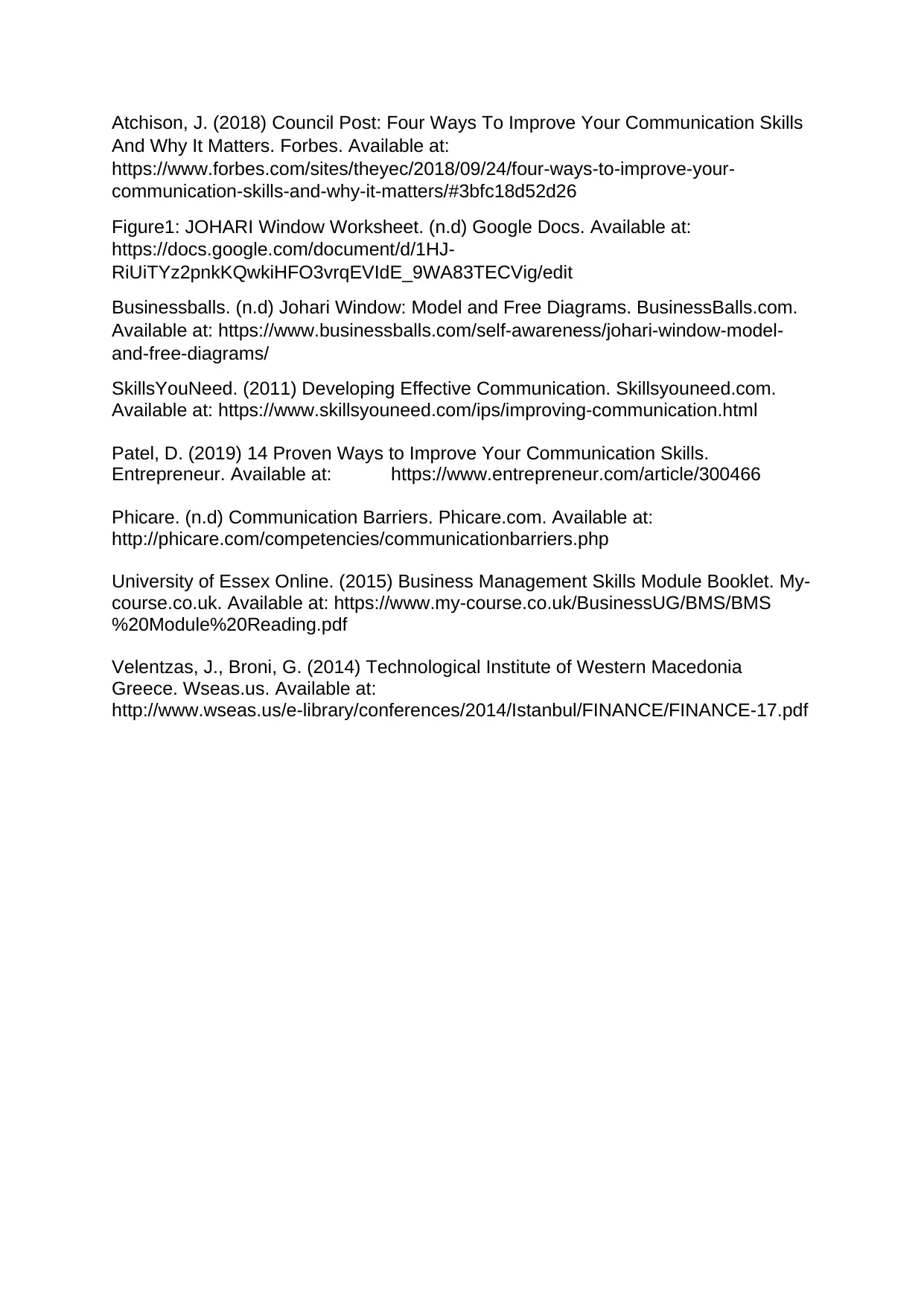
Atchison, J. (2018) Council Post: Four Ways To Improve Your Communication Skills
And Why It Matters. Forbes. Available at:
https://www.forbes.com/sites/theyec/2018/09/24/four-ways-to-improve-your-
communication-skills-and-why-it-matters/#3bfc18d52d26
Figure1: JOHARI Window Worksheet. (n.d) Google Docs. Available at:
https://docs.google.com/document/d/1HJ-
RiUiTYz2pnkKQwkiHFO3vrqEVIdE_9WA83TECVig/edit
Businessballs. (n.d) Johari Window: Model and Free Diagrams. BusinessBalls.com.
Available at: https://www.businessballs.com/self-awareness/johari-window-model-
and-free-diagrams/
SkillsYouNeed. (2011) Developing Effective Communication. Skillsyouneed.com.
Available at: https://www.skillsyouneed.com/ips/improving-communication.html
Patel, D. (2019) 14 Proven Ways to Improve Your Communication Skills.
Entrepreneur. Available at: https://www.entrepreneur.com/article/300466
Phicare. (n.d) Communication Barriers. Phicare.com. Available at:
http://phicare.com/competencies/communicationbarriers.php
University of Essex Online. (2015) Business Management Skills Module Booklet. My-
course.co.uk. Available at: https://www.my-course.co.uk/BusinessUG/BMS/BMS
%20Module%20Reading.pdf
Velentzas, J., Broni, G. (2014) Technological Institute of Western Macedonia
Greece. Wseas.us. Available at:
http://www.wseas.us/e-library/conferences/2014/Istanbul/FINANCE/FINANCE-17.pdf
And Why It Matters. Forbes. Available at:
https://www.forbes.com/sites/theyec/2018/09/24/four-ways-to-improve-your-
communication-skills-and-why-it-matters/#3bfc18d52d26
Figure1: JOHARI Window Worksheet. (n.d) Google Docs. Available at:
https://docs.google.com/document/d/1HJ-
RiUiTYz2pnkKQwkiHFO3vrqEVIdE_9WA83TECVig/edit
Businessballs. (n.d) Johari Window: Model and Free Diagrams. BusinessBalls.com.
Available at: https://www.businessballs.com/self-awareness/johari-window-model-
and-free-diagrams/
SkillsYouNeed. (2011) Developing Effective Communication. Skillsyouneed.com.
Available at: https://www.skillsyouneed.com/ips/improving-communication.html
Patel, D. (2019) 14 Proven Ways to Improve Your Communication Skills.
Entrepreneur. Available at: https://www.entrepreneur.com/article/300466
Phicare. (n.d) Communication Barriers. Phicare.com. Available at:
http://phicare.com/competencies/communicationbarriers.php
University of Essex Online. (2015) Business Management Skills Module Booklet. My-
course.co.uk. Available at: https://www.my-course.co.uk/BusinessUG/BMS/BMS
%20Module%20Reading.pdf
Velentzas, J., Broni, G. (2014) Technological Institute of Western Macedonia
Greece. Wseas.us. Available at:
http://www.wseas.us/e-library/conferences/2014/Istanbul/FINANCE/FINANCE-17.pdf
1 out of 5
Related Documents
Your All-in-One AI-Powered Toolkit for Academic Success.
+13062052269
info@desklib.com
Available 24*7 on WhatsApp / Email
![[object Object]](/_next/static/media/star-bottom.7253800d.svg)
Unlock your academic potential
Copyright © 2020–2025 A2Z Services. All Rights Reserved. Developed and managed by ZUCOL.




